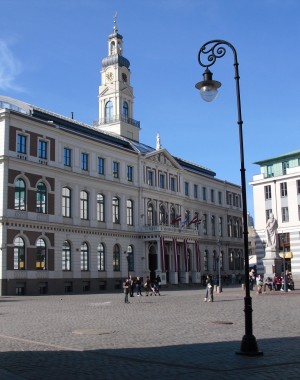Millers, Martinis, Mothers-In-Law, and Modernity in Old Riga
Its 2 a.m. in Riga, Latvia and the cobbled streets of the Old Town are crowded as usual.The little pelmeni shop, where you can eat your fill of stuffed dumplings (the ex-Soviet world’s answer to tortellini) for a dollar or two, is doing brisk business. A line of teens and 20-somethings snake out the door of Pulkvedim Neviens Neraksta (“No One Writes to the Colonel”), the reigning alternative music temple that serves as the crown jewel of the city’s booming nightlife. Windows on every street frame display views of people dancing to upbeat music: in a restaurant, so crowded that the line to get in stretches outside; in a nightclub that has reserved a window spot for a stripper pole bathed in red light; and, most unlikely, in a tearoom, where exuberant, mostly older bodies have carved out a dance floor amid the little round tables and echoes of gently clinking cups.
In the pantheon of European travel, many dismiss Riga as unappealing. It’s too crime-ridden, they say. It’s too small. Or, being a capital, it’s too expensive. They would be wrong.
Latvia is the poorest country in the European Union, but high-end Riga, its capital, is arguably the most cosmopolitan city in the Baltics, with upscale shops, new museums, modern hotels, and restaurants springing up daily with only traces of what many Latvians call the Soviet occupation remaining, amidst a duality between the old and new that defines the Baltics. Entrepreneurs here are learning that new ideas can make money. Why, for example, can’t a restaurant double as a disco at night? Why should chefs remain constrained by the traditional Latvian fare of fish, dark rye bread and boiled peas with bacon, when there are so many “fusion” ingredients like nuts and jalapeños? And why should Riga’s cultural institutions remain bound by the past?
Sure, there’s a dark past, but it’s a past that’s quickly being swept under the rug in favor of cutting-edge postmodernity. Once a tiny seaport ruled by the Germans, Swedes, and Soviets, Riga is now a metropolis of over 750,000, and, according to the last census, the only area in Latvia that has gained in population over the last 10 years.
I arrived in the city not knowing exactly what to expect. The former Eastern Bloc nations are mysterious to most American travelers, and most everything I had heard of the city had been from films and anecdotes from various acquaintances. I had only a day to see the city before flying back to Stockholm to continue my studies in Sweden, thus I deliberately did as little research beforehand as possible to avoid disappointment. A quick bus ride from the airport whizzed down a little strip of well-maintained highway and deposited me right in the heart of the Old Town, where the streets were filled with the kind of cold, harsh Nordic sunlight that can give you a headache if you’re not used to it. At first, the stark patches of light and shadow made the city feel otherworldly, like I was walking through a film set. But as I continued to walk through the maze of the bustling streets full of foreign sights, smells, and tastes, leading into half-empty corridors, shaded in mystery, I began to feel right at home.
The city may be thriving, but it is also rustic, like an old-fashioned diorama depicting the Dark Ages set amidst the most cutting-edge of museums. Near a Russian Orthodox Cathedral, two elderly women with thick shawls knotted under their chins were selling boxes of fruit. In a square just off Kalku Iela (Chalky Street), one of the main streets running through the Old Town, a small skating rink had been set up, where children skated to a crackly rendition of Lady Gaga’s “Alejandro.” Yet, despite the rural appeal, it was clear that the city is a merge between the old and the new; a converging path of what once was and what is.
Riga is said to have one of the finest collections of Art Nouveau buildings anywhere and, turning onto Alberta Iela that afternoon, I could easily believe it. An architecture buff could happily spend weeks here, working their way through the winding streets. Riga was spared the bombings that destroyed so many of Germany’s Art Nouveau buildings, which has earned it recognition as a UNESCO World Heritage Site. Much of the Old Town looks as it did before 1914, when Riga was a prosperous seafaring city with large shipyards and a thriving merchant class. Many of the elaborate, fanciful structures were designed by Baltic German architect Mikhail Eisenstein, whose son Sergei later became one of Russia’s best-known film directors. The ringing Old Town is a sea of glassy skyscrapers, a symbol of Latvia’s economic boom despite a declining population and political uncertainty following admittance to the European Union in 2004.
Of particular interest is the Vecrīga (“House of the Blackheads”). Erected during the 14th century for the Brotherhood of Blackheads — a guild for unmarried German merchants in Riga — it was rebuilt in the late 1990s after being bombed by the Germans in 1941 and demolished by the Soviets in 1948. There’s also the Freedom Monument (Latvian: Brīvības Piemineklis), a memorial honoring soldiers killed during the 1918 to 1920 Latvian War for Independence. Considered an important symbol of the sovereignty of Latvia, silent honor guards stand by in rotating shifts, not unlike the Tomb of the Unknown Soldier in Warsaw, Poland or Washington, D.C.
Amidst such a picturesque setting, one would assume the cost of lodging to be sky-high. Yet, such assumptions couldn’t be further from the truth. A modest, clean hotel in or near the Old Town costs about $100 for a double room, but I opted for a much cheaper option: one of the myriad hostels peppering the city, catering to students and young travelers.
(Article continued on next page)

